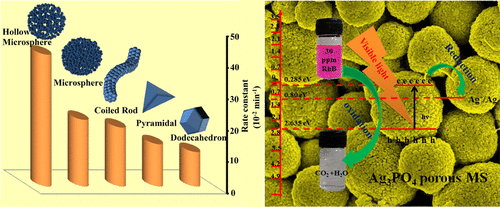当前位置:
X-MOL 学术
›
ACS Sustain. Chem. Eng.
›
论文详情
Our official English website, www.x-mol.net, welcomes your feedback! (Note: you will need to create a separate account there.)
Sustainable Design of Hierarchically Porous Ag3PO4 Microspheres through a Novel Natural Template and Their Superior Photooxidative Capacity
ACS Sustainable Chemistry & Engineering ( IF 8.4 ) Pub Date : 2017-11-16 00:00:00 , DOI: 10.1021/acssuschemeng.7b03391 Subrata Mandal 1 , Rajakumar Ananthakrishnan 1
ACS Sustainable Chemistry & Engineering ( IF 8.4 ) Pub Date : 2017-11-16 00:00:00 , DOI: 10.1021/acssuschemeng.7b03391 Subrata Mandal 1 , Rajakumar Ananthakrishnan 1
Affiliation

|
Uniform hierarchical Ag3PO4 porous microspheres were synthesized for the first time by a sustainable route based on a novel natural bone glue (BG)-assisted one-step precipitation reaction at room temperature. By varying experimental conditions such as the bone glue content, template constituents (amino acid, alginic acid), precursor concentration, temperature, pH, and reaction time, we could tune the morphology, porosity, size, and properties of Ag3PO4. All of the phases, microstructures with different architectures, and textural properties of the Ag3PO4 were characterized by Fourier transform infrared spectroscopy, X-ray diffraction, scanning electron microscopy, transmission electron microscopy, Brunauer–Emmett–Teller surface area analysis, and UV–vis diffuse reflectance spectroscopy. The oxidation state, local structure, and purity of the prepared Ag3PO4 were further characterized by X-ray photoelectron spectroscopy, Raman spectroscopy, and thermogravimetric analysis. The influence of the template on the morphology was characterized by syntheses of Ag3PO4 using different templates such as glycine, alanine, and alginic acid, and products such as pyramidal-shaped Ag3PO4, Ag3PO4 dodecahedra, and coiled-rod-like porous Ag3PO4 were obtained, respectively. This revealed that self-assembly of the collagen protein present in the bone glue plays a significant role as a structure-directing agent, crystal growth modifier, and aggregation-orienting agent in the formation of unique Ag3PO4 porous microspheres. Detailed photocatalytic studies on aqueous rhodamine B and 2,4-dichlorophenol (2,4-DCP) in the presence of Ag3PO4 porous microspheres exhibited enhanced photocatalytic degradation under visible light that was significantly higher than for other architectures. The findings of this study should offer new insights into the development of porous hierarchical materials as high-performance visible-light photocatalysts and their potential utilization in environmental sustainability.
中文翻译:

通过新型天然模板及其优异的光氧化能力可持续设计多孔Ag 3 PO 4多层微球
基于新型天然骨胶(BG)辅助的一步沉淀法,在室温下,通过可持续途径首次合成了均匀的分级Ag 3 PO 4多孔微球。通过改变实验条件,例如骨胶含量,模板成分(氨基酸,藻酸),前体浓度,温度,pH和反应时间,我们可以调整Ag 3 PO 4的形态,孔隙率,尺寸和性能。Ag 3 PO 4的所有相,具有不同结构的微结构和组织性质通过傅里叶变换红外光谱,X射线衍射,扫描电子显微镜,透射电子显微镜,Brunauer-Emmett-Teller表面积分析和UV-vis漫反射光谱进行表征。通过X射线光电子能谱,拉曼光谱和热重分析进一步表征了制备的Ag 3 PO 4的氧化态,局部结构和纯度。模板对形态的影响是通过使用不同的模板(例如甘氨酸,丙氨酸和藻酸)合成Ag 3 PO 4以及产品(例如金字塔形的Ag 3 PO 4,Ag 3 PO 4)来表征的。分别获得十二面体和盘状棒状多孔Ag 3 PO 4。这表明存在于骨胶中的胶原蛋白的自组装在独特的Ag 3 PO 4多孔微球的形成中作为结构导向剂,晶体生长调节剂和聚集定向剂起着重要作用。Ag 3 PO 4存在下对若丹明B水溶液和2,4-二氯苯酚(2,4-DCP)的详细光催化研究多孔微球在可见光下表现出增强的光催化降解作用,这明显高于其他结构。这项研究的结果应为多孔多层材料作为高性能可见光光催化剂的开发及其在环境可持续性方面的潜在利用提供新的见解。
更新日期:2017-11-16
中文翻译:

通过新型天然模板及其优异的光氧化能力可持续设计多孔Ag 3 PO 4多层微球
基于新型天然骨胶(BG)辅助的一步沉淀法,在室温下,通过可持续途径首次合成了均匀的分级Ag 3 PO 4多孔微球。通过改变实验条件,例如骨胶含量,模板成分(氨基酸,藻酸),前体浓度,温度,pH和反应时间,我们可以调整Ag 3 PO 4的形态,孔隙率,尺寸和性能。Ag 3 PO 4的所有相,具有不同结构的微结构和组织性质通过傅里叶变换红外光谱,X射线衍射,扫描电子显微镜,透射电子显微镜,Brunauer-Emmett-Teller表面积分析和UV-vis漫反射光谱进行表征。通过X射线光电子能谱,拉曼光谱和热重分析进一步表征了制备的Ag 3 PO 4的氧化态,局部结构和纯度。模板对形态的影响是通过使用不同的模板(例如甘氨酸,丙氨酸和藻酸)合成Ag 3 PO 4以及产品(例如金字塔形的Ag 3 PO 4,Ag 3 PO 4)来表征的。分别获得十二面体和盘状棒状多孔Ag 3 PO 4。这表明存在于骨胶中的胶原蛋白的自组装在独特的Ag 3 PO 4多孔微球的形成中作为结构导向剂,晶体生长调节剂和聚集定向剂起着重要作用。Ag 3 PO 4存在下对若丹明B水溶液和2,4-二氯苯酚(2,4-DCP)的详细光催化研究多孔微球在可见光下表现出增强的光催化降解作用,这明显高于其他结构。这项研究的结果应为多孔多层材料作为高性能可见光光催化剂的开发及其在环境可持续性方面的潜在利用提供新的见解。



























 京公网安备 11010802027423号
京公网安备 11010802027423号